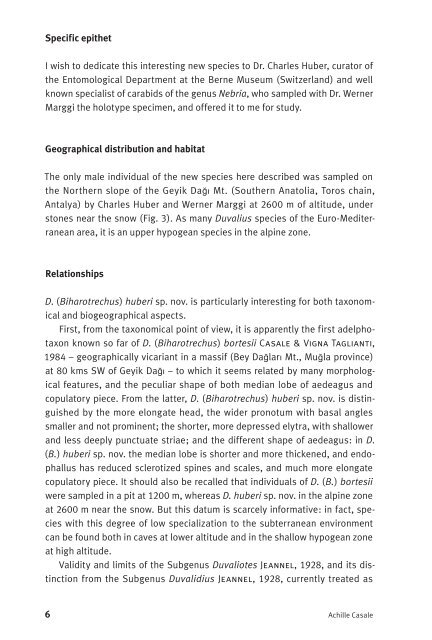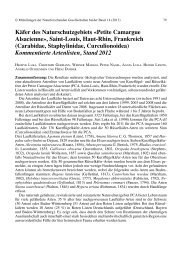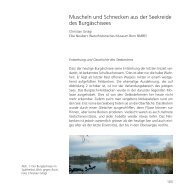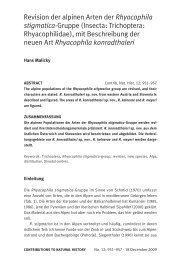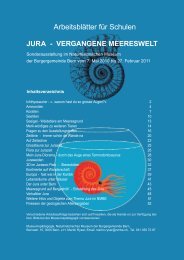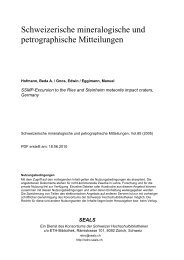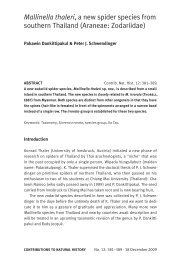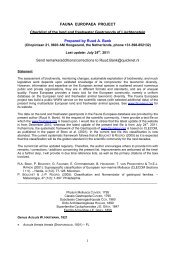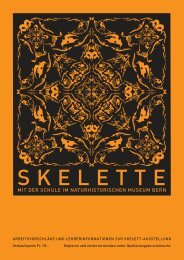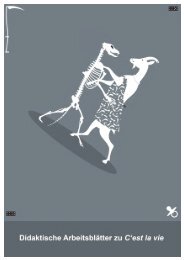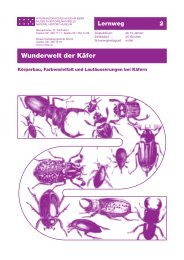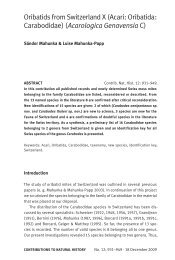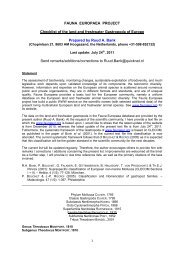Biharotrechus - Naturhistorisches Museum Bern
Biharotrechus - Naturhistorisches Museum Bern
Biharotrechus - Naturhistorisches Museum Bern
Create successful ePaper yourself
Turn your PDF publications into a flip-book with our unique Google optimized e-Paper software.
Specific epithet<br />
I wish to dedicate this interesting new species to Dr. Charles Huber, curator of<br />
the Entomological Department at the <strong>Bern</strong>e <strong>Museum</strong> (Switzerland) and well<br />
known specialist of carabids of the genus Nebria, who sampled with Dr. Werner<br />
Marggi the holotype specimen, and offered it to me for study.<br />
Geographical distribution and habitat<br />
The only male individual of the new species here described was sampled on<br />
the Northern slope of the Geyik Dağı Mt. (Southern Anatolia, Toros chain,<br />
Antalya) by Charles Huber and Werner Marggi at 2600 m of altitude, under<br />
stones near the snow (Fig. 3). As many Duvalius species of the Euro-Mediterranean<br />
area, it is an upper hypogean species in the alpine zone.<br />
Relationships<br />
D. (<strong>Biharotrechus</strong>) huberi sp. nov. is particularly interesting for both taxonomical<br />
and biogeographical aspects.<br />
First, from the taxonomical point of view, it is apparently the first adelphotaxon<br />
known so far of D. (<strong>Biharotrechus</strong>) bortesii Casale & Vigna Taglianti,<br />
1984 – geographically vicariant in a massif (Bey Dağları Mt., Muğla province)<br />
at 80 kms SW of Geyik Dağı – to which it seems related by many morphological<br />
features, and the peculiar shape of both median lobe of aedeagus and<br />
copulatory piece. From the latter, D. (<strong>Biharotrechus</strong>) huberi sp. nov. is distinguished<br />
by the more elongate head, the wider pronotum with basal angles<br />
smaller and not prominent; the shorter, more depressed elytra, with shallower<br />
and less deeply punctuate striae; and the different shape of aedeagus: in D.<br />
(B.) huberi sp. nov. the median lobe is shorter and more thickened, and endophallus<br />
has reduced sclerotized spines and scales, and much more elongate<br />
copulatory piece. It should also be recalled that individuals of D. (B.) bortesii<br />
were sampled in a pit at 1200 m, whereas D. huberi sp. nov. in the alpine zone<br />
at 2600 m near the snow. But this datum is scarcely informative: in fact, species<br />
with this degree of low specialization to the subterranean environment<br />
can be found both in caves at lower altitude and in the shallow hypogean zone<br />
at high altitude.<br />
Validity and limits of the Subgenus Duvaliotes Jeannel, 1928, and its distinction<br />
from the Subgenus Duvalidius Jeannel, 1928, currently treated as<br />
6 Achille Casale


